|
Subpage
bugs in the garden: "Water
bugs"
Shield
bugs (Pentatomoidea)
Plantbugs
(Miridae)
Cicadas
Aphids
 Nederlands /
Dutch Nederlands /
Dutch
Seed
bugs, ground bugs (Lygaeidea) in the garden.
Information about bugs:
True bugs can be found both in and on water and on land. They also have a
sucking mouthparts known as a rostrum.
With this rostum they suck juices from all kinds. That can be plants and seeds, but also insects and other animals. They belong to the order Hemiptera
like aphids
and cicadas.
The true bugs have forewings that are hardened at the base and membranous
at the tips. They sit flat over the abdomen hiding the membranous hind
wings. Hemiptera
means “half wing. They
are held flat on the back, with the ends overlapping. (Hardened
forewings like the beetles have, but the forewings of beetles meet
together in a straight line on their back)
The larva (nymph) resembles a miniature wingless adult, although their colour and markings may be very
different. The nymphs progress
through a series of moults (known as instars) .
The wings are developed in the last instar. ( incomplete metamorphosis, there is not a pupal
stage). There are five instars.
In and near water, these families are on this website: Corixidae, Gerridae,
Hydrometridae, Nepidae, Naucoridae, Notonectidae, Saldidae.
There are many families. Well known is the superfamily Pentatomoidea, which is divided into 14-15 families.
Such as the families Stink bugs (Pentatomidae), Acanthosomatidae, Burrower Bugs
(Cydnidae), Jewel bugs (Scutelleridae), ebony bugs (Thyreocoridae) with in the Netherlands
only the Thyreocoris scarabaeoides and since 2021 the family Plataspidae with in the Netherlands
only the Thyreocoris scarabaeoides.
Other true bugs families on this website are: Minute pirate bugs, Flower bugs (Anthocoridae) , Squash bugs,
Leaf-footed bug (Coreidae) , Seed bugs, Ground bugs (Lygaeidae),
Plant bugs (Miridae), Nabidae, Scentless plant bugs (Rhopalidae), Reduviidae,
Lace bugs (Tingidae).
|
Seed Bugs or Ground Bugs
(Lygaeidae).
The seed bugs or ground bugs (Lygaeinae) occur worldwide. It is a large family of mostly dark
coloured bugs, but in the subfamily Lygaeinae are also bright red seed bugs. Most species in the subfamily Lygaeinae
live in the tropics.
They often live on the soil and feed on plants and seeds. There are also species that can be found in trees. Most species overwinter as adult. In the
Netherlands are about 100 species.
There is also another classification of seed bugs by Henry, T. J. (1997) with a superfamily Lygaeoidea. The subfamilies are changed in families. For example, the subfamily Rhyparochrominae is changed in the family Rhyparochromidae. However, the Netherlands still maintained the
classification into subfamilies.
Subfamily Cyminae.
The subfamily includes four wantons from the genus Cymus. All four species suck on monocot seeds such as grasses. They are densely
punctated.
 .. ..
 . .
 Cymus glandicolor.
Subfamily Cyminae. Family Seed Bugs or Ground Bugs
(Lygaeidae). Not in the garden but in the dunes
about 4 km from our house.
Cymus glandicolor.
Subfamily Cyminae. Family Seed Bugs or Ground Bugs
(Lygaeidae). Not in the garden but in the dunes
about 4 km from our house.
A light brown bug with a dark brown spot on the front wings.
The shape of the stain distinguishes it from other species of the genus
Cymus.
The adult bug overwinters. The new generation will appear from July.
Length 3.7-5.1 mm. Europe, Asia (Siberia, China, Japan).
Photos 17-7-2017. |
 The cymus nymphs look very similar. I found this with the other two Cymus
glandicolor. But it can also be another one. Photo 17-7-2017.
The cymus nymphs look very similar. I found this with the other two Cymus
glandicolor. But it can also be another one. Photo 17-7-2017. |
 .. ..
 Cymus melanocephalus.
Subfamily Cyminae. Family Seed Bugs or Ground Bugs
(Lygaeidae). Not in the garden but in the
meadow about 3 km from our house.
Cymus melanocephalus.
Subfamily Cyminae. Family Seed Bugs or Ground Bugs
(Lygaeidae). Not in the garden but in the
meadow about 3 km from our house.
A light brown
bug with a dark brown spot on the front wings. The head is brown to black brown. The dark head distinguishes
it from other species of the genus Cymus. If he has a slight head, he is more difficult to distinguish.
The adult bug overwinters. The new generation will appear from July.
Length 3.1-3.9 mm. Europe, North Africa, East to Central Asia. Photos 28-87-2017. |
Subfamily Ischnorhynchinae.
A small subfamily with Netherlands in three types, which are quite similar. Namely Kleidocerys
ericae,
on heath. The Kleidocerys privignus, on alder. The Kleidocerys resedae, which occur in large numbers on birch or near birches. The other two species are rarer.
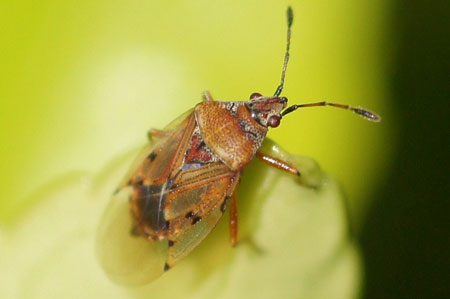 .. ..
 . .
 . .
 Birch
Catkin Bug
(Kleidocerys
resedae).
Subfamily Ischnorhynchinae.
Family Seed Bugs or Ground Bugs
(Lygaeidae).
Birch
Catkin Bug
(Kleidocerys
resedae).
Subfamily Ischnorhynchinae.
Family Seed Bugs or Ground Bugs
(Lygaeidae).
There are many in our garden. A beautiful small
brown bug. They hibernate as adult.
Length: 4-5 mm. All the year.
But!!!!! in the Netherlands there are two very, very similar species (not common). Kleidocerys privignus on alder and Kleidocerys ericae on heath.
German: Birkenwanze.
Nymph Kleidocerys resedae,
different stadium. March - September. They feed on seeds of the birch.



 |
Subfamily Orsillinae.
In the Netherlands there are in this subfamily seven Nysius species, the Orsillus depressus and the Ortholomus
punctinipennis.
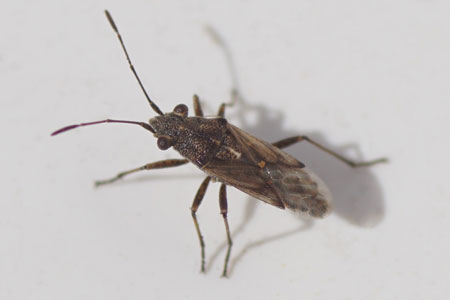 Nysius helveticus.
Subfamily Orsillinae. Family Seed Bugs or Ground Bugs
(Lygaeidae). Not in the garden but in the
meadow about 3 km from our house.
Nysius helveticus.
Subfamily Orsillinae. Family Seed Bugs or Ground Bugs
(Lygaeidae). Not in the garden but in the
meadow about 3 km from our house.
Bugs from the genus Nysius are very similar. In the Netherlands there are also: Nysius
cymoides, Nysius ericae, Nysius graminicola, Nysius huttoni, Nysius senecionis and Nysius
thymi. A brown bug with a clear light keel over pronotum and scutellum, which it can recognize from the other species.
They mainly live on seeds of heather. Less often from cinquefoils and plants from the composites family.
They overwinter as eggs and sometimes at high temperatures as nymph.
Length 4.3-6 mm. Europe, Asia Minor, Central Asia and China. Photo 4-7-2018. |
Subfamily Rhyparochrominae.
Tribe Drymini.
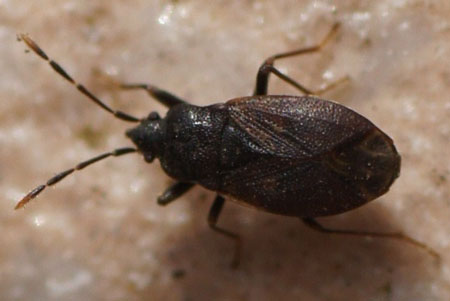 .. ..
 Drymus brunneus.
Tribe Drymini.
Subfamily Rhyparochrominae.
Family Seed Bugs or Ground Bugs
(Lygaeidae).
Drymus brunneus.
Tribe Drymini.
Subfamily Rhyparochrominae.
Family Seed Bugs or Ground Bugs
(Lygaeidae).
I thought it was another Drymus ryeii, because I see them often.
Fortunately I have taken some pictures. It is a different species. A small bug like Drymus brunneus is not so easy to recognize.
If you look at the picture, you see clear differences. The shin and the top part of the antenna are light brown.
The forewings are brown and remarkably wide in the middle.
Adult: All year.
Length 3,6-5,4 mm.
Photos 24-03-2012. |
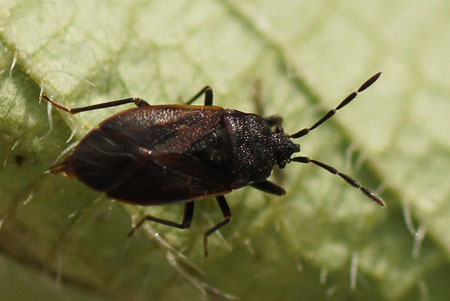 .. ..
 . .
 . .
 Drymus ryeii. Tribe Drymini. Subfamily
Rhyparochrominae. Family Seed Bugs or Ground Bugs
(Lygaeidae).
Drymus ryeii. Tribe Drymini. Subfamily
Rhyparochrominae. Family Seed Bugs or Ground Bugs
(Lygaeidae).
Drymus reyii is similar to Drymus sylvaticus. It is a dark bug. The wings are usually dark brown to black, but sometimes lighter.
In our garden it's the most common Drymus.
Adult: All year.
Length 3,6-4,7 mm.
Photos 26-10-2011, 13-4-2008. |
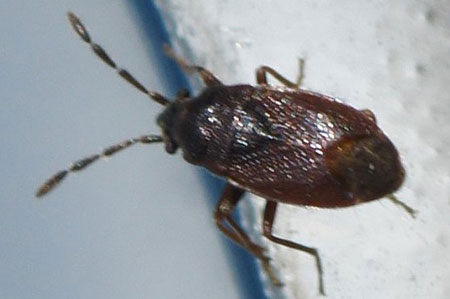 Male:
Male:  Female:
Female:  Drymus pumilio.
Tribe Drymini. Subfamily Rhyparochrominae. Family Seed Bugs or Ground Bugs
(Lygaeidae).
Drymus pumilio.
Tribe Drymini. Subfamily Rhyparochrominae. Family Seed Bugs or Ground Bugs
(Lygaeidae).
Drymus pumilio, together with the Drymus pilicornis, is the smallest species in the genus
Drymus. The antennae are brown-black. In the females, segment 1 and lower part of segment 2 are brown. Head and scutellum are brown black. The front wings are brown.
In the Netherlands they are very rare. Even in Europe they are not found so often.
They live from seeds in wet or damp moss on sand or limestone soil. These bugs are in the moss at our pond.
Adult: All year.
Length 2.4-3 mm. Photos 18-7-2017, 19-7-2017. |
 
|
The nymph, I found is a Drymus. (Drymus spec.) Photo 19-9-2008.
|
 .. ..
 . .
 . .
 Eremocoris plebejus.
Tribe Drymini. Subfamily Rhyparochrominae.
Family Seed Bugs or Ground Bugs
(Lygaeidae).
Eremocoris plebejus.
Tribe Drymini. Subfamily Rhyparochrominae.
Family Seed Bugs or Ground Bugs
(Lygaeidae).
This unclear photo I took, while
it was was running away over a piece of chipboard. It was not until 2018 that I saw it again in the garden. I often see them in the dunes. Other photos have been taken there.
Eremocorisspecis are distinguished by the two yellow-white spots on the membrane. The forewings are dark
red-brown or red-brown.
It lives in dry pine forests with sandy or calcareous soil and is often found on moss or between the pine needles on the ground.
The adult bug overwinters. In August the new adult bugs appear. Length 5-7 mm.
Europe, Asia. Foto's 22-05-2010. 24-9-2016, 6-10-2016, 10-4-2018.


  3-8-2015, 24-9-2016,
28-9-2016. Nymphs in different stages. Difference with the nymphs of the Eremocoris abietis
are the hairy shins.
3-8-2015, 24-9-2016,
28-9-2016. Nymphs in different stages. Difference with the nymphs of the Eremocoris abietis
are the hairy shins.
|
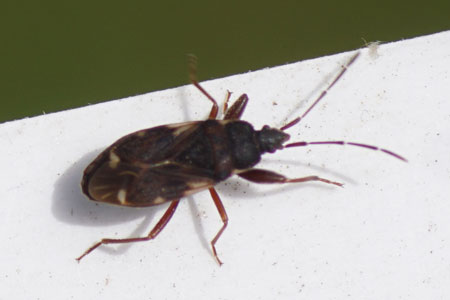 .. ..
 Eremocoris podagricus.
Tribe Drymini. Subfamily Rhyparochrominae.
Family Seed Bugs or Ground Bugs
(Lygaeidae).
Eremocoris podagricus.
Tribe Drymini. Subfamily Rhyparochrominae.
Family Seed Bugs or Ground Bugs
(Lygaeidae).
Resembles Eremocoris plebejus The forewings reddish brown with black markings, a whitish yellow part near the scutellum, a whitish yellow spot at the edge about one third. The membrane with whitish veins. The adult bug
overwinters. The new adult bugs appear in August. Length 5.5-7 mm. Formerly rare in the Netherlands. Europe, North Africa, Asia Minor, the Caucasus. Photos 4-5-2023.
|
 .. ..
 . .
 Eremocoris abietis.
Tribe Drymini. Subfamily Rhyparochrominae. Family Seed Bugs or Ground Bugs
(Lygaeidae). Not in the garden but in the dunes
about 4 km from our house.
Eremocoris abietis.
Tribe Drymini. Subfamily Rhyparochrominae. Family Seed Bugs or Ground Bugs
(Lygaeidae). Not in the garden but in the dunes
about 4 km from our house.
Like the Eremocoris plebejus an inhabitant of the dry pine forests with sandy soil.
It is often found on moss or pine needles on the ground. It is also found under larch, juniper, blueberry or heather. A nice bug with partly
pale and partly red-brown forewings.
The adult bug overwinters. In August the new adult bugs appear. Length 5.9 to 7.2 mm.
Europe, Asia.
Photos 9-09-2015. |
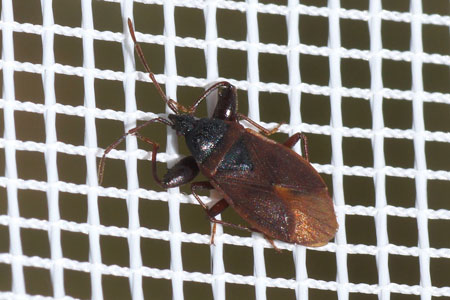 .. ..
 . .
 Nymph
Nymph
 Pine Cone Bug (Gastrodes grossipes). Tribe
Drymini. Subfamily Rhyparochrominae.
Family Seed Bugs or Ground Bugs
(Lygaeidae). Not in the garden but in the dunes
about 4 km from our house.
Pine Cone Bug (Gastrodes grossipes). Tribe
Drymini. Subfamily Rhyparochrominae.
Family Seed Bugs or Ground Bugs
(Lygaeidae). Not in the garden but in the dunes
about 4 km from our house.
A reddish-brown flat bottom bug with broad abdomen and wings. He can be found on pine trees where they suck the
seeds. It looks at the paler Gastrodes abietum, which occurs on spruce.
The adult bug overwinters.
The whole year. Europe and Asia Minor.
Length 6-7 mm. Photos 20-04-2015,
20-4-2015.
German:
Kiefernzapfenwanze. |
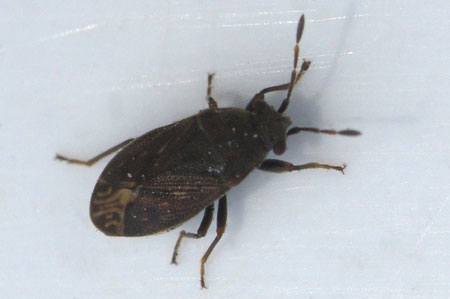 Stygnocoris fuligineus.
Tribe Drymini. Subfamily Rhyparochrominae.
Family Seed Bugs or Ground Bugs
(Lygaeidae). Not in the garden but on the edge of the dunes and a field about 2 km from our house.
Stygnocoris fuligineus.
Tribe Drymini. Subfamily Rhyparochrominae.
Family Seed Bugs or Ground Bugs
(Lygaeidae). Not in the garden but on the edge of the dunes and a field about 2 km from our house.
The rather dull brown forewings are covered with short hairs. Black antennae. Segment 2 and 3 are often at the top
(3 sometimes entirely) brown. Legs with black thighs and brown shins. Head and pronotum are black, rear part of the pronotum is blackish brown.
Stygnocoris sabulosus resembles the Stygnocoris fuligineus. But Stygnocoris fuligineus has light
legs and antennae (Only the last segment is dark) and shinier. The third species in the Netherlands
is Stygnocoris rusticus. Stygnocoris rusticus is more blackish.
Especially on warm, dry places with a rich herbal vegetation. No preference for any type of soil.
The adult bugs and sometimes nymphs overwinter. Two generations in one year.
Length 2.5 - 3.3 mm.
The new generation of adult bugs appears in August. Photo 31-3-2017. |
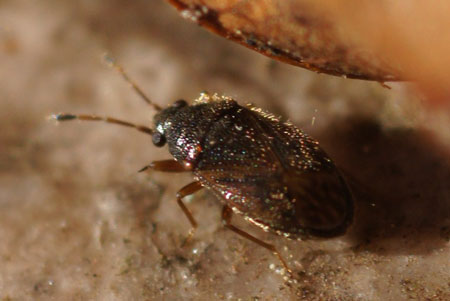 .. ..
 Stygnocoris sabulosus. Tribe
Drymini. Subfamily Rhyparochrominae.
Family Seed Bugs or Ground Bugs
(Lygaeidae).
Stygnocoris sabulosus. Tribe
Drymini. Subfamily Rhyparochrominae.
Family Seed Bugs or Ground Bugs
(Lygaeidae).
The brown forewings are covered with hairs. Pale legs and antennae. Only the last segment is dark. Head and pronotum are black or black-brown.
Particularly on dry, sandy places. Seeds of many different types of herbaceous plants and grasses. But they are mainly found in heather.
The eggs overwinter and hatch in the spring of. Most ground bugs overwinter
as adults.
Length 2.4 - 3.2 mm.
August - October. Photos 17-10-2010. |

|
The nymph I found is a Stygnocoris (Stygnocoris
spec.)
Photo 17-6-2017.
|
Scolopostethus: In the Netherlands there are a number of species,
which are similar. The differences are small. (colour of antennae, legs
and wing length.)
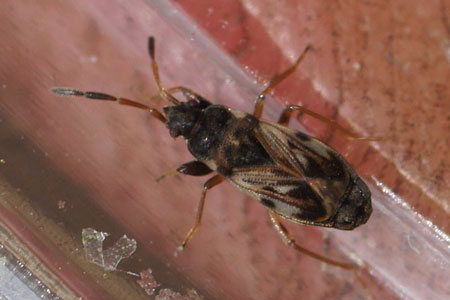 .. ..
 . .
 Scolopostethus affinis. Tribe
Drymini. Subfamily Rhyparochrominae.
Family Seed Bugs or Ground Bugs
(Lygaeidae).
Scolopostethus affinis. Tribe
Drymini. Subfamily Rhyparochrominae.
Family Seed Bugs or Ground Bugs
(Lygaeidae).
Scolopostethus affinis mostly has short wings, but sometimes they are
long winged (macropteer) and than they are difficult to determine from a
photo. Antennae: Segment 1 en 2 are
pale brown, segment 2
en 3 are dark brown. (sometimes the base of segment 3 is pale too). The legs
are pale brown, the front femur is sometimes darker brown. The live
in leaf litter under herbaceous plants, often near nettle.
The adult bug overwinters and sometimes nymphs of a second generation. In July, August, the next generation. Length 3,1 – 4 mm.
Europe. East to Western Siberia and Asia Minor and the area near the Caspian Sea.
Photos 14-6-2011, 14-42013, 25-4-2013.
 'Hook' on the mesosternum. (between the fore legs
and the middle legs)
'Hook' on the mesosternum. (between the fore legs
and the middle legs)
|
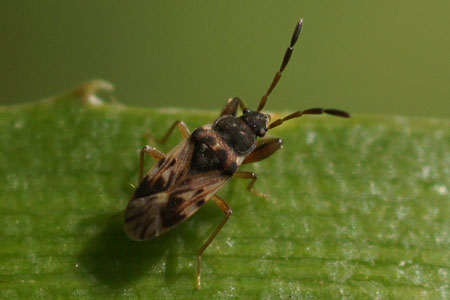 .. ..
 . .
 . .
 Maybe!!!!! Scolopostethus
affinis. Tribe Drymini. Subfamily
Rhyparochrominae.
Family Seed Bugs or Ground Bugs
(Lygaeidae).
Maybe!!!!! Scolopostethus
affinis. Tribe Drymini. Subfamily
Rhyparochrominae.
Family Seed Bugs or Ground Bugs
(Lygaeidae).
Two examples of long winged scolopostethus species. They are not to identify with certainty.
I have written about all the characteristics of the different species of
the genus Scolopostethus. The problem is that a characteristic as the
colour of the antennae usually is right, but not always for there are exceptions
and that makes difficult to identify some bugs without doubts.
Photo 22-09-2010, 19-8-2015.
 13-4-2016
13-4-2016
|
 .. ..
 . .
 Scolopostethus
decoratus.
Tribe Drymini. Subfamily Rhyparochrominae.
Family Seed Bugs or Ground Bugs
(Lygaeidae). Scolopostethus
decoratus.
Tribe Drymini. Subfamily Rhyparochrominae.
Family Seed Bugs or Ground Bugs
(Lygaeidae).
Always long winged, macropteer. Antennae: Segment 2 lower part is pale brown, the upper part of the antennae is dark.
Legs pale are pale brown to darker brown. Front femur dark. - Near heather, bilberry.
They are often found near heather and bilberry (they feed on seeds of
these plants) between the leaves and moss on the ground, but als on the
plants.
The adults hibernate. (Photo 2-11-09) In August, the next generation appears. Length
3,1 – 4 mm.
It is found in Europe, North Africa and to the east to Asia Minor.
Photos 27-3-2019, 23-2-2019. |
 .. ..
 . .
 . .  Scolopostethus grandis.
Tribe Drymini. Subfamily Rhyparochrominae.
Family Seed Bugs or Ground Bugs
(Lygaeidae).
Scolopostethus grandis.
Tribe Drymini. Subfamily Rhyparochrominae.
Family Seed Bugs or Ground Bugs
(Lygaeidae).
Wings are slightly shorter, rarely long winged. - Antennae: Segment 1 and the lower part of segment 2 are pale brown, the other part of the antennae is dark. - Legs are mostly pale brown to darker brown. The front femur is darker brown. the bug in the picture is missing an antenna segment.
They often are found in damp places, between the leaves and moss on the
ground.
The adults hibernate. Length 3,7 - 5 mm. Europe. East to Western Siberia, Asia Minor and the Caucasus.
Photos 16-10-2016. Small picture: Like S. affinis
a 'hook' on the mesosternum (between the fore legs
and the middle legs). First two photos taken in the dunes, the last two photos in the garden of a female with relatively light
antennae. |
 .. ..
 .
.  Scolopostethus pictus. Tribe
Drymini. Subfamily Rhyparochrominae.
Family Seed Bugs or Ground Bugs
(Lygaeidae).
Scolopostethus pictus. Tribe
Drymini. Subfamily Rhyparochrominae.
Family Seed Bugs or Ground Bugs
(Lygaeidae).
This species always has long wings. The antennae
and legs are pale brown, the upper part sometimes a bit darker.. The thighs of the legs are very thick.
They often are found in damp places, between the leaves and moss on the
ground.
The adult bug overwinters and sometimes nymphs of a second generation. (Photo 2-11-09) In
July, August, the next generation appears. Length 3,9 – 4,8 mm mm.
Europe. Eastward to Siberia, Asia Minor and the Caucasus.
Left:
Photos 9-2-2011.
|
The characteristics of the different species of Scolopostethus, but the
colour of the antennas is not a quite hard characteristic and then it's a lot
more difficult to find the name.
Scolopostethus affinis: 3,1 – 4 mm. - Short winged, macropteer (membrane
short) occasionally long winged, brachypteer . - Antennae: Segment 1 en 2 are
pale brown, segment 3 and 4 are dark brown. (sometimes the base of segment 3 is pale too) - Legs are pale brown,
front femur is sometimes darker brown. - Herbaceous plants, often near nettle.
Scolopostethus decoratus: 3,6 – 4,2 mm. - Always long winged,
macropteer. - Antennae:
Segment 2 lower part is pale brown, the upper part of the antennae is dark. - Legs pale
are pale brown to darker brown. Front femur dark. - Near heather, bilberry.
Scolopostethus grandis: 3,7 – 5 mm. - Wings are slightly shorter,
rarely long winged. - Antennae: Segment 1 and the lower part of segment 2 are
pale brown, the other part of the antennae is dark. - Legs are mostly pale brown
to darker brown. The front femur is darker brown.
Scolopostethus pictus: 3,9 – 4,8 mm. - Antennae: Pale brown, the
upper part sometimes a bit darker. -
Always long winged. - Legs are pale brown.
Scolopostethus pilosus: 3,6 – 4,4 mm. - Sortwinged, rarerely
long winged. - Antennae: Segment 1 and the lower part of segment 2 pale brown.
the other part of the antennae is dark.. - Legs are pale brown, the front femur
is dark brown. .
Scolopostethus puberulus: 3,2 – 4,3 mm. - Short winged,
sometimes long winged. - Antennae: Segment 1, 2 are pale brown, segment 2, 3 are dark brown with sharp contrast.
- Legs are pale brown.
Scolopostethus thomsoni: 3,4 – 4 mm. - Sort winged (membrane
very short) and long winged. - Antennae: Segment 1 and the lower part of segment 2
are pale brown, the other part of the antennae is dark. (not always) - Legs are
pale brown, front femur is dark brown.. - Particularly near nettle.
Scolopostethus grandis and Scolopostethus affinis have on the mesosternum two distinct 'hooks' in males and two less clear nodules in females.

|
Nymph Scolopostethus. Photo 21-7-2011.
|
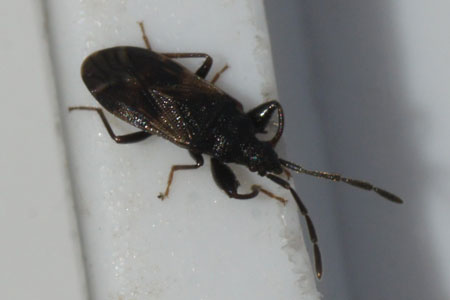 .. ..
 . .
 Taphropeltus contractus.
Tribe Drymini. Subfamily Rhyparochrominae.
Family Seed Bugs or Ground Bugs
(Lygaeidae). Not in the garden but in the dunes
about 4 km from our house.
Taphropeltus contractus.
Tribe Drymini. Subfamily Rhyparochrominae.
Family Seed Bugs or Ground Bugs
(Lygaeidae). Not in the garden but in the dunes
about 4 km from our house.
The head of the Taphropeltus is constricted behind the eyes. The eyes are quite far from the
pronotum. The head, pronotum and scutellum are black. The dark forewings are partly yellowish brown.
The adult bug overwinters.
Dry, warm, open to partial shaded habitats such as forest edges. It feeds on seeds on the bottom. In mating season, they are also found on the plants.
The whole year. Europe. North Africa, Asia.
Length 3,2 - 3,7 mm. Photos 28-9-2016, 15-3-2017.
|
Tribe Gonianotini.
 .. ..
 Macrodema microptera.
Tribe Gonianotini. Subfamily Rhyparochrominae.
Family Seed Bugs or Ground Bugs
(Lygaeidae). Not in the garden but in the dunes
about 4 km from our house.
Macrodema microptera.
Tribe Gonianotini. Subfamily Rhyparochrominae.
Family Seed Bugs or Ground Bugs
(Lygaeidae). Not in the garden but in the dunes
about 4 km from our house.
A shiny black bug with light brown wings. Usually they are brachypteer like
in this photo. Sometimes macropteer. The posterior of the black pronotum
is brown.
In the Netherlands it is common on the higher sandy soils inland and in the dunes. They live on the ground at heath of the seeds and young leaves of heather and also of spring tails.
The adult bug overwinters. In July a new generation of adult bugs.
Length 3,1-3,9 mm. Photos 4-8-2017. |
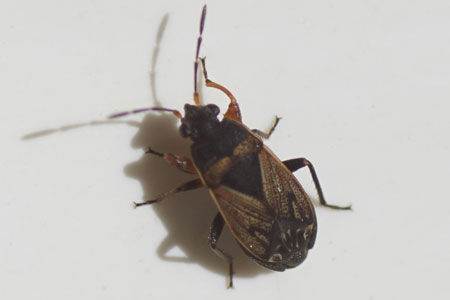 Male: Trapezonotus
spec.
Tribe Gonianotini. Subfamily Rhyparochrominae.
Family Seed Bugs or Ground Bugs
(Lygaeidae). Not in the garden but in the dunes
about 4 km from our house.
Male: Trapezonotus
spec.
Tribe Gonianotini. Subfamily Rhyparochrominae.
Family Seed Bugs or Ground Bugs
(Lygaeidae). Not in the garden but in the dunes
about 4 km from our house.
A trapezoidal pronotum. The three species are vry similar, so that they often cann't be determined from a photograph. Also because the colour can vary. Long-winged
(macropterous) and short-winged ( brachypterous). A gray-black head, scutellum and front part of the
pronotum. The back of the pronotum is brown with black dots. Brown forewings. Black antennae. In males, segment 1 is yellow-brown.
Species are
Trapezonotus arenarius: Rarely brachypterous. 4.1-5 mm. Warm, dry areas with sandy soil (coastal and land dunes).
Trapezonotus desertus: Rarely macropterous. 3.7-4.7 mm. Dry to moderately moist areas (heather, light pine forests).
Trapezonotus dispar: Macropterous and brachypterous. 4.6-5.3 mm. Dry to moderately moist areas. (edge of deciduous forests or in light deciduous forests).
Foto26-09-2018. |
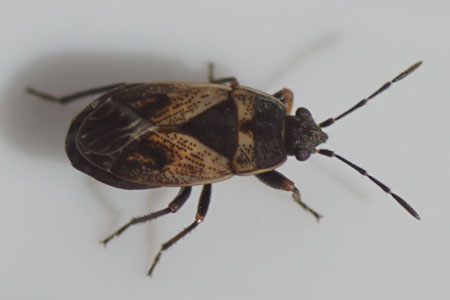 .. ..
 Trapezonotus
arenarius.
Tribe Gonianotini. Subfamily Rhyparochrominae.
Family Seed Bugs or Ground Bugs
(Lygaeidae). Niet
in de tuin, maar in de duinen ongeveer 4 km van ons huis. Trapezonotus
arenarius.
Tribe Gonianotini. Subfamily Rhyparochrominae.
Family Seed Bugs or Ground Bugs
(Lygaeidae). Niet
in de tuin, maar in de duinen ongeveer 4 km van ons huis.
These two bugs could be determined by Berend Aukema. Two different species found in the same place.
Trapezonotus arenarius: Rarely
brachypterous. 4.1-5 mm. Warm, dry areas with sandy soil (coastal and land dunes).
Photos 5-10-2018. |
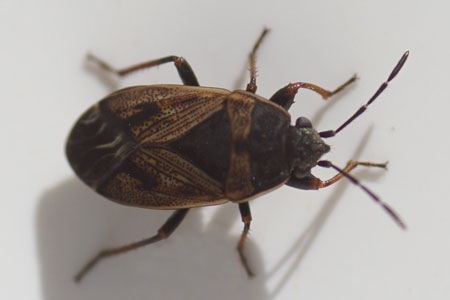 .. ..  Trapezonotus dispar.
Tribe Gonianotini. Subfamily Rhyparochrominae.
Family Seed Bugs or Ground Bugs
(Lygaeidae). Niet
in de tuin, maar in de duinen ongeveer 4 km van ons huis.
Trapezonotus dispar.
Tribe Gonianotini. Subfamily Rhyparochrominae.
Family Seed Bugs or Ground Bugs
(Lygaeidae). Niet
in de tuin, maar in de duinen ongeveer 4 km van ons huis.
Trapezonotus dispar: Macropterous and
brachypterous. 4.6-5.3 mm. Dry to moderately moist areas. (edge of deciduous forests or in light deciduous forests).
Photos 26-09-2018. |
Tribe Megalonotini.
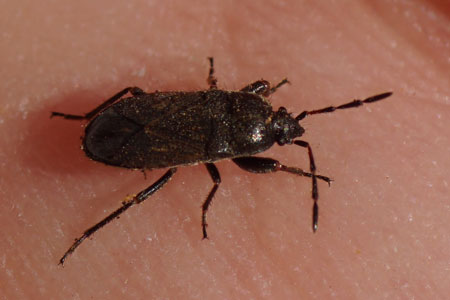 .. ..
 Megalonotus chiragra.
Tribe Megalonotini.
Subfamily Rhyparochrominae.
Family Seed Bugs or Ground Bugs
(Lygaeidae.
Megalonotus chiragra.
Tribe Megalonotini.
Subfamily Rhyparochrominae.
Family Seed Bugs or Ground Bugs
(Lygaeidae.
Black with brown wings. Black antennae. Segment 2 is tan and distal black. With upright hairs, which makes the bug in the photo messy on its back, because it was lying on its back in the tray when I caught it between the leaf litter. Sucks on all kinds of seeds on the soil.
They mainly occur on sandy soil. Adult bugs hibernate. One generation in a year. Length 5.2-6.7 mm. Photos 15-09-2020. |
Tribe Plinthisini.
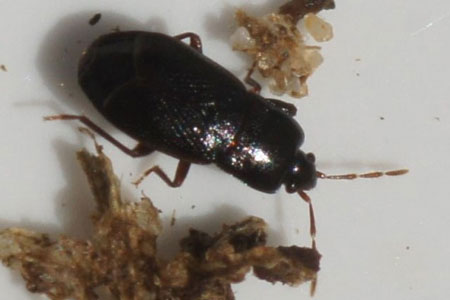 Plinthisus brevipennis.
Tribe Plinthisini. Subfamily Rhyparochrominae.
Family Seed Bugs or Ground Bugs
(Lygaeidae). Not in the garden but in the dunes
about 4 km from our house.
Plinthisus brevipennis.
Tribe Plinthisini. Subfamily Rhyparochrominae.
Family Seed Bugs or Ground Bugs
(Lygaeidae). Not in the garden but in the dunes
about 4 km from our house.
A small shiny black bug. It usually is brachypteer, but also can be
macropteer. The head is relatively small. It looks like the smaller Plinthisus
pusillus. However Plinthisus brevipennis has a broad
punctured band on the pronotum along the scutellum.
They feed on seeds on the bottom. In mating season, they are also found on plants.
The adult bug overwinters. In late July the new adult bugs appear. Length about 2.8 - 3.5 mm
Europe, North Africa, Asia.
Photo 24-09-2016.
|
Tribe Rhyparochromini.
 .. ..
 Beosus maritimus. Tribe Rhyparochromini. Subfamily
Rhyparochrominae.
Family Seed Bugs or Ground Bugs (Lygaeidae).
Beosus maritimus. Tribe Rhyparochromini. Subfamily
Rhyparochrominae.
Family Seed Bugs or Ground Bugs (Lygaeidae).
A brown bug with distinctive white spots on the
dark cuneus.
On the dark scutellum are two elongated light spots. Pale brown legs with a dark part. The fourth dark segment of the antenna is on the base light.
They occur mainly on sandy soils. Here it is on our terrace.
Adults overwinter.
Adult: All year.
Length 6-7 mm.
Photos 11-04-2014. |
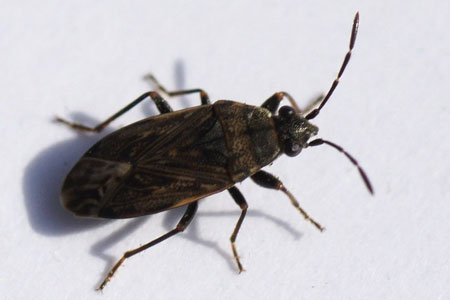 .. ..
 . .
 Lighter:
Lighter:
 . .
 Peritrechus nubilus. Tribe
Rhyparochromini. Subfamily Rhyparochrominae.
Family Seed Bugs or Ground Bugs
(Lygaeidae).
Peritrechus nubilus. Tribe
Rhyparochromini. Subfamily Rhyparochrominae.
Family Seed Bugs or Ground Bugs
(Lygaeidae).
Peritrechus nubilus resembles Peritrechus geniculatus. Difference:
The 3rd segment of the antenna of Peritrechus nubilus is thinner than the
1st segment and the leading edge of the
probotum is yellow-brown.
Usually, there is a clear pale spot at the base of the membrane.
Length 5-6 mm.
All year. Photos 22-9-2014, 11-4-2018 ( A lighter
Peritrechus nubilus). |
Some species of the family seed bugs, ground bugs (Lygaeoidae) I
photographed in France. More information in Insects
in France
Subfamily Orsillinae. Family Lygaeidae.
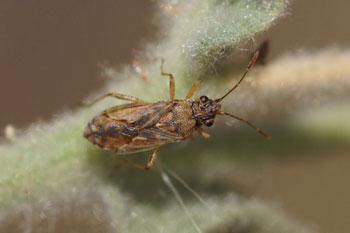 Nysius cf graminicola. Subfamily Orsillinae. Family: Seed Bugs or Ground Bugs
(Lygaeidae).
Nysius cf graminicola. Subfamily Orsillinae. Family: Seed Bugs or Ground Bugs
(Lygaeidae).
|
Subfamily Lygaeinae. Family Lygaeidae.
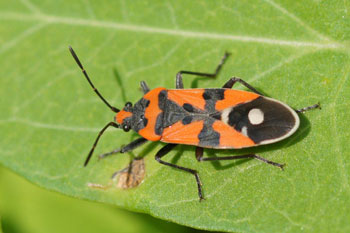 Lygaeus equestris, Lygaeus simulans. Subfamily Lygaeinae. Family Seed Bugs or Ground Bugs
(Lygaeidae).
Lygaeus equestris, Lygaeus simulans. Subfamily Lygaeinae. Family Seed Bugs or Ground Bugs
(Lygaeidae). |
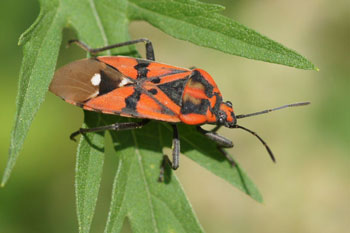 Lygaeus pandurus (nowadays also called Spilostethus).
Subfamily Lygaeinae. Family: Seed Bugs or Ground Bugs
(Lygaeidae).
Lygaeus pandurus (nowadays also called Spilostethus).
Subfamily Lygaeinae. Family: Seed Bugs or Ground Bugs
(Lygaeidae). |
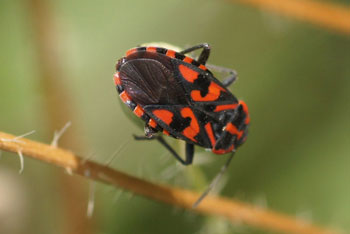 Spilostethus saxatilis. Subfamily Lygaeinae. Family: Seed Bugs or Ground Bugs
(Lygaeidae).
Spilostethus saxatilis. Subfamily Lygaeinae. Family: Seed Bugs or Ground Bugs
(Lygaeidae). |
Two species of the family seed bugs, ground bugs (Lygaeoidae) I
photographed in Croatia.
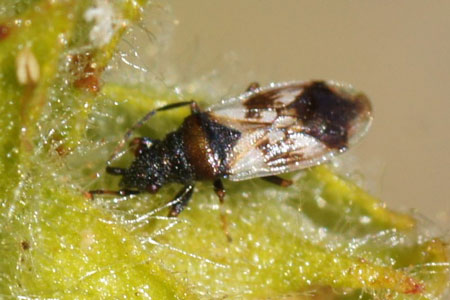 Macroplax fasciata. Subfamily Oxycareninae.
Family: Seed Bugs or Ground Bugs
(Lygaeidae).
Macroplax fasciata. Subfamily Oxycareninae.
Family: Seed Bugs or Ground Bugs
(Lygaeidae). |
 Proderus bellevoyei. Tribe Megalonotini. Subfamily
Rhyparochrominae. Family: Seed Bugs or Ground Bugs
(Lygaeidae).
Proderus bellevoyei. Tribe Megalonotini. Subfamily
Rhyparochrominae. Family: Seed Bugs or Ground Bugs
(Lygaeidae). |
I want to thank Berend Aukema for the determination of many of my bugs.
Nederlands /
Dutch
 
Subpage bugs in
the garden: "Water
bugs"
Shield
bugs (Pentatomoidea)
Plantbugs
(Miridae)
Cicadas
Aphids
Subpage France:
Insects
France
|
